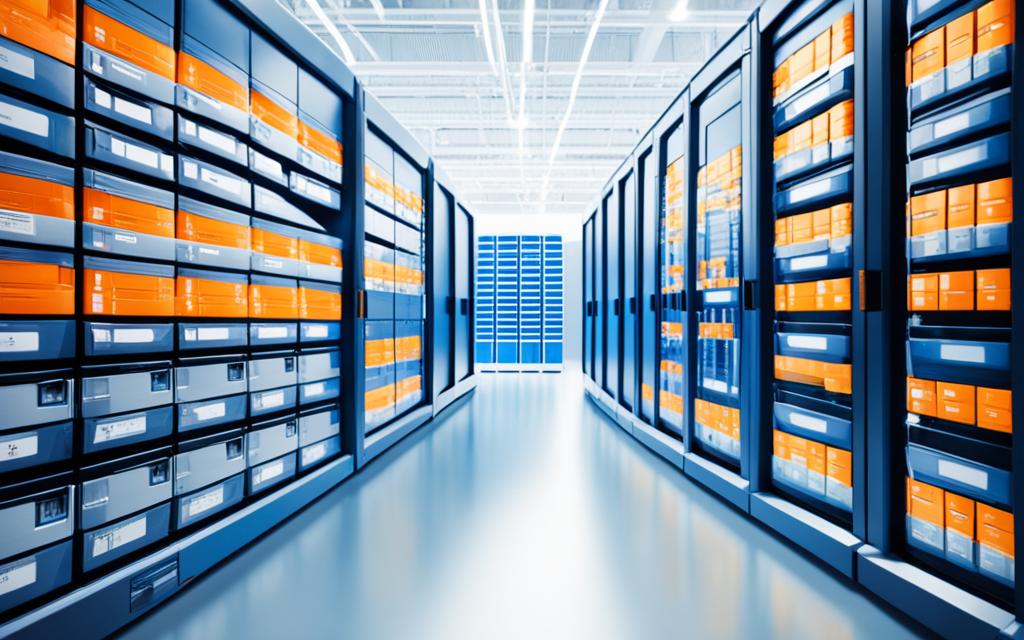Table of Contents
Primary storage, or main memory, is crucial for computer operations. It allows computers to easily access currently used data and programs. Located on the motherboard, it supports speedy read and write actions. This speed boosts the computer’s overall performance and efficiency. The importance of primary storage is increasing, with data storage markets expected to hit over $50 billion by 20241. Knowing how computer memory works is key to understanding how computers function smoothly.
Key Takeaways
- Primary storage is integral to a computer’s performance.
- It facilitates quick access to active data crucial for processing tasks.
- Understanding the types of primary storage aids in optimising technology use.
- The global market for data^ storage reflects the increasing demand for efficient memory solutions.
- Primary storage architecture often includes both solid-state drives and hard disks.
What is Primary Storage on a Computer?
Primary storage is the core that helps a computer work without hitches. It’s tasked with holding and accessing data needed for daily tasks. Such storage is key for speedy data access, which many applications rely on.
Definition and Purpose
The term definition of primary storage includes various memory types. These are built for quick data retrieval. It’s crucial for businesses needing fast access and high-performance levels. Gartner states that primary storage takes care of persistent data in environments like hybrid clouds, involving a mix of locations2.
Importance in Computer Operations
The purpose of primary storage stands out because it boosts computer speed. By linking with the processor, it fetches data faster than secondary storage. RAM, Cache, and Registers are vital in this setup, handling active data for smooth operation23.
Importance in Computer Operations
Knowing primary storage’s role highlights its value in system speed. Volatile RAM provides swift access to needed data. Cache Memory offers even quicker retrieval. This makes primary storage a must-have for running the system and applications well3.
| Aspect | Primary Storage | Secondary Storage |
|---|---|---|
| Purpose | Fast access for active processes | Long-term storage for non-critical data |
| Volatility | Volatile | Non-volatile |
| Speed of Access | Rapid | Slower |
| Media Types | RAM, Cache, Registers | HDDs, SSDs |
Types of Primary Storage
It’s key to know the types of primary storage to make a computer work better. There are two main kinds: volatile and non-volatile memory. Both have different roles in a computer. Volatile memory loses its data when we switch off the power. Non-volatile memory doesn’t forget information, which is necessary for keeping important instructions and data safe.
Volatile vs Non-Volatile Memory
Volatile memory, such as RAM (Random Access Memory), is essential for running applications well. On the other side, non-volatile memory holds ROM (Read-Only Memory). ROM keeps system information and firmware safe, even when there’s no power.
RAM (Random Access Memory)
RAM helps a computer do many things at once. Computers can have from 1GB to 64GB of RAM, based on their model4. Having more RAM means the computer can store and reach many data points at once. This improves how well the computer works and makes it run smoother5.
ROM (Read-Only Memory)
ROM plays a crucial part in starting up a computer. It holds the firmware needed for booting. As it doesn’t lose data without power, ROM is a trustworthy source for the initial steps of an operating system.
Cache Memory
Cache memory keeps frequently used data close to the CPU, which cuts down on retrieval time. Even though it’s smaller than RAM, it’s faster. This means it can quickly get to important information5.
Flash Memory
Flash memory, found in SSDs and USB drives, is a common non-volatile storage option. SSDs have speeds that are 10 times faster than older hard disks. This big leap in speed makes the system more responsive and changes how we store data4. It’s now quicker and more reliable.
The Role of Primary Storage in Performance
Understanding the big role of primary storage in computer performance is key. It shapes how well a system can handle data speeds. This affects the whole system’s efficiency. Quick access to often-used data through primary storage makes everything work better. This boosts productivity and makes using the computer more enjoyable.
Speed and Accessibility of Data
Data speed is vital in computers. RAM, very common in primary storage, allows for quick app use and multitasking. It makes programs run smoothly and quickly. Cache memory, closer to the CPU, speeds up access to often-used data6. With DDR SDRAM and SRAM, data suffers minimal delays. This keeps multi-tasking efficient7.
Impact on System Efficiency
Primary storage’s role in system efficiency is huge. It leads to smoother running software, with quicker starts and operations. Boosting primary storage, like more RAM or better cache memory, lifts performance in demanding tasks. This is crucial for handling complex applications in Database Systems and Machine Learning6.Cache memory’s role in cutting down delay matters a lot in gaming. It means faster access to important game data, reducing lag and improving the gaming experience6.
Trends and Innovations in Primary Storage Technology
The world of primary storage technology is changing fast. Innovations are reshaping how we store and access our data. With more demands for quick data access, memory tech is advancing. This is changing the game for data storage and use.
Evolving Memory Technologies
New improvements in memory tech have brought us NVMe SSDs. They are key because they work much faster than old storage ways. Now, SSDs can hold several terabytes, thanks to tech like QLC NAND flash. This allows more data storage and is cost-efficient. Also, 3D NAND tech is making SSDs even better by stacking memory cells vertically. This means more space and better8.
Future of Primary Tenhnologies
In the future, we’ll see amazing things like quantum data storage. It aims for huge storage spaces and stronger security with quantum encryption9. Cloud storage is also changing the game. It lets businesses easily adjust their storage needs. Plus, Software-Defined Storage (SDS) is making it easier to meet different business needs. This is crucial in a world that’s always changing8.
Conclusion
Primary storage plays a key role in how computers work. It lets them access data quickly and run programs smoothly. This storage is crucial for boosting a system’s speed and efficiency. It makes sure data is ready right when the CPU and apps need it. There are different kinds of primary storage, like RAM, ROM, and Cache Memory. These help organisations manage data well, keeping up with new computing needs1011.
Staying up-to-date with primary storage technology helps make better choices about storage setups. This knowledge improves coding and software building. It highlights how important primary storage is to computer systems. By investing in the latest primary storage, companies see big improvements in how they operate. They get more efficient and stronger in handling different tasks.
Understanding primary storage’s place in computing helps organisations use it to its full advantage. This keeps them ahead in a world where technology changes fast. They enjoy better performance and good data management. These are among the many advantages of focusing on primary storage’s essential role in today’s computer systems10.
FAQ
What is primary storage in computer systems?
Primary storage, or main memory, is where data and programs in use live. It’s on the motherboard for quick access. This boosts processing speed and efficiency greatly.
How does primary storage differ from secondary storage?
Secondary storage holds data that isn’t used often. But primary storage is for data that needs fast access. It’s key for applications that require quick data retrieval and processing.
What are the types of primary storage?
Primary storage types include volatile and non-volatile. Volatile memories, like RAM, lose data without power. Non-volatile memories, such as ROM and flash memory, keep their data without a power source.
Why is primary storage important for system performance?
Primary storage’s speed is vital for computing efficiency. It lets the CPU quickly get and run instructions. This cuts down on wait times and boosts system responsiveness.
What role do innovations play in primary stalkkk>
Innovations in primary storage, like the use of SSDs, boost performance. They’re making old hard drives less common. This shows how data storage is changing and improving.
How will the primary storage market evolve in the future?
The demand for both primary and secondary storage is growing because of more data. The global data storage market might reach over billion by 2024. This highlights the need for good data management.
Source Links
- https://www.arcserve.com/blog/primary-storage-vs-secondary-storage-whats-difference – Primary Storage vs. Secondary Storage: What’s the Difference?
- https://www.purestorage.com/knowledge/primary-vs-secondary-storage.html – Primary Storage vs. Secondary Storage: What’s the Difference? | Pure Storage
- https://www.studysmarter.co.uk/explanations/computer-science/computer-organisation-and-architecture/primary-storage/ – Primary Storage: Types & Importance
- https://www.geeksforgeeks.org/what-is-a-storage-device-definition-types-examples/ – What is a Storage Device? Definition, Types, Examples – GeeksforGeeks
- https://www.lenovo.com/us/en/glossary/primary-storage-devices/ – Inside the Core: Unveiling the Secrets of Primary Storage Devices
- https://www.lenovo.com/us/outletus/en/glossary/primary-storage-devices/ – Inside the Core: Unveiling the Secrets of Primary Storage Devices
- https://cards.algoreducation.com/en/content/veUHcxK3/primary-storage-computing – Definition and Role of Primary Storage
- https://www.nakivo.com/blog/data-storage-trends/ – Data Storage Technologies Trends for 2023
- https://intervision.com/blog-5-emerging-trends-in-data-management-and-storage/ – Staying Ahead of the Curve: 5 Emerging Trends in Data Management and Storage
- https://www.geeksforgeeks.org/primary-storage-device/ – Primary Storage Device – GeeksforGeeks
- https://www.vaia.com/en-us/explanations/computer-science/computer-organisation-and-architecture/primary-storage/ – Primary Storage: Types & Importance








